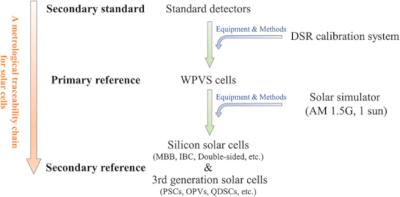Researchers from China's Fujian Metrology Institute, National Photovoltaic Industry Measurement and Testing Center and Fujian Key Laboratory of Energy Measurement have developed a metrological traceability system for both silicon and perovskite solar cells.
The metrological traceability system of solar cells. Image from: Measurement: Sensors
The calibration system consists of a monochromatic light system, a bias light system, a 3D-motion measurement platform with temperature control, and an electrical measurement system.
In their recent work, the team explained that three methods are currently used for calibration and traceability of the reference solar cells, namely direct sunlight method, differential spectral responsivity (DSR) method, and solar simulator method. "The Physikalisch-Technische Bundesanstalt in Germany (PTB), the National Institute of Metrology in China (NIM), and the Industrial Technology Research Institute in Taiwan (ITRI) use the DSR method, which is easy to manage the sources of uncertainty, and the maximum uncertainty comes from the traceability of the standard detector. The DSR calibration system of the PTB currently has an uncertainty of 0.56 % in measuring the short circuit current of the reference solar cells, and those of the NIM and the ITRI have uncertainties of 0.9 % and 0.7 %, respectively".
The team established the new system by referring to the IEC 60904-4 standard, which sets the requirements for calibration procedures for the traceability of silicon solar cells, and the IEC 60904-2 standard, which sets the requirements for the classification, selection, packaging, marking, calibration and care of photovoltaic reference devices.
“We firstly developed a differential spectral responsivity (DSR) calibration system and the corresponding measurement method, then used this system to accomplish calibration transfer from the standard detector to the World Photovoltaic Scale (WPVS) solar cell serving as the primary reference, thereby building the measuring capability for primary reference solar cells,” the scientists explained.
The proposed DSR method can measure the absolute spectral responsivity of a WPVS solar cell under a white bias light of 1000 W/m2 in the range of its effective response wavelength. Then, it can compare these values with those of the reference solar spectral distribution AM1.5 according to the IEC 60904-3 standard, which describes basic measurement principles for determining the electrical output of PV devices, and calculate the calibration value of the WPVS solar cell.
The entire procedure is implemented by maintaining the temperature of the reference solar cell and the standard detectors at 25 C, using a white bias light that is adjustable in the irradiance range of 0.01-1.2 sun, and utilizing a uniform monochromatic light that is adjustable between 280 nm and 1200 nm.
The group also created equipment suitable for both silicon and perovskite cells and said this equipment allows to use solar simulators to evaluate cell performance by transferring data from WPVS PV devices to the secondary reference solar cells.
The calibration system consists of a monochromatic light system, a bias light system, a 3D motional measurement platform with temperature control, and an electrical measurement system.
The monochromatic light system is equipped with a xenon lamp, a halogen lamp, two monochromators with 3 gratings, a chopper, a filter wheel, and an optical lens module, while the bias light system uses a halogen lamp array and programmable DC power supply. Furthermore, the measurement platform consists of a 3D high-precision automatic displacement platform, a temperature-controlled platform, and a programmable high-precision temperature-controlled system. Finally, the electrical measurement system is based on two signal preamplifiers, two lock-in amplifiers, a high-precision digital multimeter with a multi-channel data acquisition device, and a data acquisition software.
"The developed calibration system participated in international comparison twice, demonstrating an uncertainty of 0.7 % (k = 2) and realizing “international equivalence”, which is up to world-class level", the team stated.
The new system was introduced in the study “The establishment of a metrological traceability system for solar cells,” published in Measurements: Sensors.




